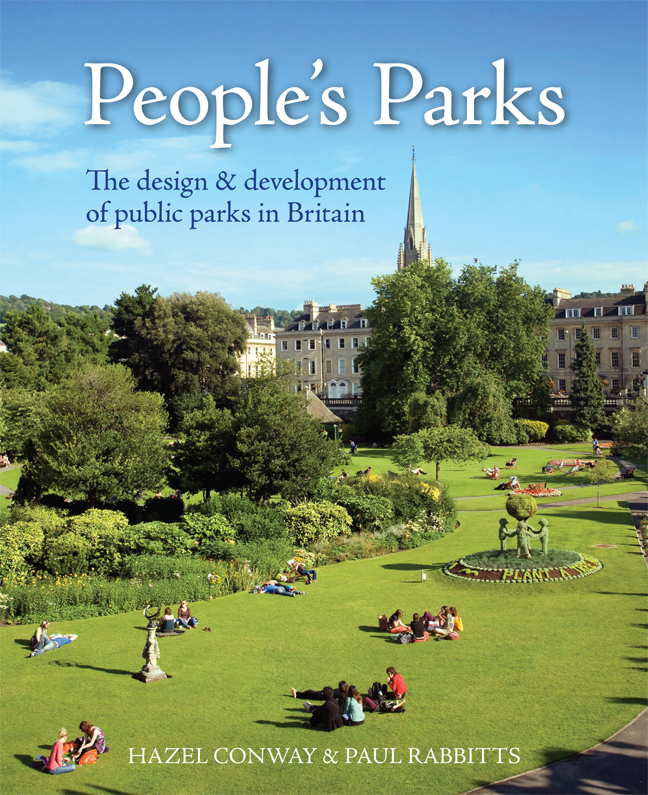Book contents
- Frontmatter
- Dedication
- Contents
- Miscellaneous Frontmatter
- Preface
- Acknowledgements
- Foreword
- A Word from Parks Professionals, Politicians and Parks Organisations
- Introduction: Dr Hazel Conway (1991)
- 1 Public Parks and Municipal Parks
- 2 The Need for Parks
- 3 Pioneering Parks Development
- 4 The Park Movement
- 5 Design and Designers
- 6 Lodges, Bandstands and the Cultivation of Virtue
- 7 Local Pride and Patriotism
- 8 Planting and Park Maintenance
- 9 Permitted Pastimes
- 10 Recreation Grounds, Parks and the Urban Environment
- 11 Public Parks, 1885–1914
- 12 Later Municipal Park Designers
- 13 Garden Cities and the New Towns Movement
- 14 Sport, Physical Activity and Recreation in Public Parks in the Inter-war Years
- 15 Parks Management – a Changing Perspective
- 16 Decline, Revival and Renewal – the Role of Parks into 21st-century Britain
- Appendix 1 Summary of main legislation promoting early park development
- Appendix 2 Chronology of main municipal and public park developments between 1800 and 1885
- Notes
- Bibliography
- Subscription List
- Index
13 - Garden Cities and the New Towns Movement
Published online by Cambridge University Press: 22 February 2024
- Frontmatter
- Dedication
- Contents
- Miscellaneous Frontmatter
- Preface
- Acknowledgements
- Foreword
- A Word from Parks Professionals, Politicians and Parks Organisations
- Introduction: Dr Hazel Conway (1991)
- 1 Public Parks and Municipal Parks
- 2 The Need for Parks
- 3 Pioneering Parks Development
- 4 The Park Movement
- 5 Design and Designers
- 6 Lodges, Bandstands and the Cultivation of Virtue
- 7 Local Pride and Patriotism
- 8 Planting and Park Maintenance
- 9 Permitted Pastimes
- 10 Recreation Grounds, Parks and the Urban Environment
- 11 Public Parks, 1885–1914
- 12 Later Municipal Park Designers
- 13 Garden Cities and the New Towns Movement
- 14 Sport, Physical Activity and Recreation in Public Parks in the Inter-war Years
- 15 Parks Management – a Changing Perspective
- 16 Decline, Revival and Renewal – the Role of Parks into 21st-century Britain
- Appendix 1 Summary of main legislation promoting early park development
- Appendix 2 Chronology of main municipal and public park developments between 1800 and 1885
- Notes
- Bibliography
- Subscription List
- Index
Summary
The development of garden cities
The earliest attempts to design the perfect city go all the way back to ancient times and eventually led to the concept of the ideal city of the Renaissance world. The dominant factor of the time, however, was the need to defend towns and cities. Requirements were for defensive systems which meant that geometric order was the overriding factor in planning cities. Well-arranged defensive emplacements determined the internal order of cities. Later utopian ideas were to eventually emerge centred around the vision of an ideal society based on a set of principles. These included, in the 16th century, Thomas More (1477–1535) who described his principles in his book, Utopia, published in 1516. More envisioned cities dominated by craft and agriculture with commerce condemned, with markets and common dining halls serving the communities. Hospitals and abattoirs were located outside the city wall.
Charles Fourier (1772–1837) was a French utopian socialist who presented his vision as his City of Garantism. His system was described as a series of three rings which were separated by hedges. Commerce was located in the centre, industry surrounded it, and to the outside was located agriculture. Fourier believed organising work to be the guarantee of economic growth.
It was, though, the emergence of industry that led to the change and distortion of historic cities across the country. Towns and cities experienced an unprecedented pace of growth. With such advances of industry, society was transformed and the opportunities of life and living conditions changed completely, leading to the creation of slums in many cities. As a result, cholera epidemics were common and mortality rates were high. In 1842, Edwin Chadwick had published his report made to the Poor Law Commission, The Sanitary Condition of the Labouring Population of Great Britain.
It was not only existing towns and cities that were transformed. New settlements appeared where water and raw materials were available to accommodate the new labour force that was required. With a number of these newly built communities, opportunities for social reforms presented themselves. The most spectacular of these developments were primarily due to industrialists whose philanthropic nature aided the realisation of their schemes. Nagy and Szelenyi cited the need to create ‘a sound basis for production and the improvement of living conditions of workers which became part of the concept of modernity and technical innovation’.
- Type
- Chapter
- Information
- People's ParksThe design & development of public parks in Britain, pp. 217 - 224Publisher: Boydell & BrewerPrint publication year: 2023

